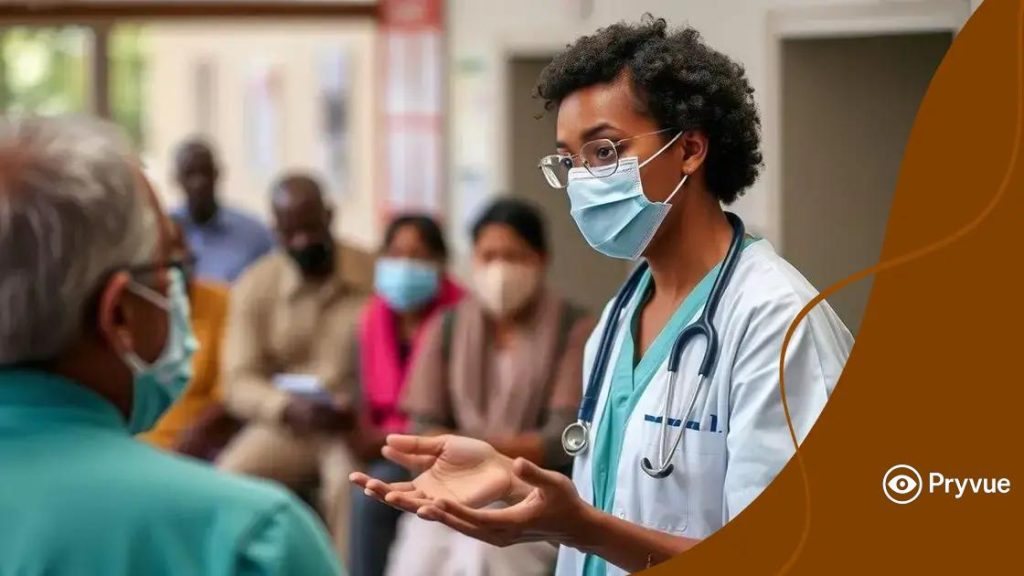Public health news US: what you need to know today

Anúncios
Community health initiatives improve public health by providing education, enhancing access to healthcare services, and fostering community support, ultimately empowering individuals to take charge of their well-being.
Public health news US is constantly evolving, and it’s essential to stay informed about the latest developments. From groundbreaking research to new health policies, every update can impact your daily life. What are the key stories today that you should be aware of?
Anúncios
Current trends in public health in the US
Staying updated on current trends in public health in the US is essential for understanding how health policies and practices evolve. Recent years have seen significant changes that affect various aspects of healthcare delivery, access, and outcomes.
Emerging Health Issues
One major trend is the rise of mental health awareness. Public health experts are increasingly recognizing the importance of mental health as a crucial part of overall well-being. There has been a significant push to integrate mental health services within primary care settings.
- Increased funding for mental health programs
- Telehealth options for mental health consultations
- Community awareness campaigns
Another important trend is the focus on preventative care. Public health initiatives aim to reduce the incidence of disease before it starts. This approach encourages people to make healthier choices to avoid health issues later on.
Anúncios
Technological Advancements
Technology is playing a vital role in shaping public health strategies. From data collection to analysis, advances in technology allow for better tracking of disease outbreaks and health trends.
Moreover, mobile health applications are becoming popular tools for individuals to monitor their health, leading to greater engagement in personal health management.
Community Health Interventions
Public health authorities are increasingly working closely with communities to address health disparities. Programs are being designed to target specific populations that may face barriers to healthcare access.
- Mobile clinics reaching underserved areas
- Localized health education programs
- Partnerships with community organizations
Such interventions not only improve health outcomes but also empower communities to take charge of their health.
Impact of COVID-19 on healthcare systems
The impact of COVID-19 on healthcare systems has been profound and far-reaching. As the pandemic unfolded, it highlighted both strengths and weaknesses within health services globally.
Immediate Strain on Resources
Initially, healthcare facilities faced overwhelming demand. Hospitals filled quickly with patients, and this surge stressed resources like beds and medical equipment. Many institutions had to adapt rapidly to manage the crisis.
- Increased need for ventilators and personal protective equipment
- Staff shortages due to illness or quarantine
- Overloaded emergency departments
This situation forced hospitals to implement emergency protocols, prioritizing care while navigating unprecedented challenges.
Telehealth Transformation
One significant shift was the rapid adoption of telehealth services. With social distancing measures in place, healthcare providers turned to virtual consultations to continue patient care.
This transition allowed for continuity in managing chronic conditions and mental health, leading to broader acceptance of telehealth options.
- Convenience for patients
- Broader access to specialists
- Cost-effective care delivery
The success of these services has led many to advocate for their permanence in the healthcare system.
Long-term Changes in Public Health Policy
The pandemic resulted in changes to public health policies. Governments responded by enhancing data collection and sharing practices, improving the preparedness for future health crises.
Additionally, funding for public health infrastructure has seen an increase, addressing gaps revealed by the pandemic.
Healthcare systems are now focusing more on preventive care and health equity, aiming to reduce disparities that were magnified during the crisis.
Legislative changes affecting public health

Legislative changes are crucial in shaping the landscape of public health. These changes can influence access to care, funding, and the overall health of communities throughout the United States.
New Health Policies
In recent years, there have been several significant policy shifts aimed at improving healthcare access. These new regulations often focus on expanding coverage and protecting vulnerable populations.
- Strengthening Medicaid expansion in various states
- Implementing protections for individuals with pre-existing conditions
- Increasing funding for mental health services
Such policies are designed to ensure that more people have access to necessary medical services.
Adjustments in Vaccination Laws
Vaccination laws have also seen changes, influenced by public health needs and community safety. States are updating their requirements and processes to encourage higher vaccination rates.
These updated laws aim to promote herd immunity and protect communities from preventable diseases.
- Stricter rules on school vaccination requirements
- Increased public awareness campaigns about vaccines
- Broader access to vaccination clinics
The goal is to educate the public and reduce misinformation regarding vaccines.
Funding for Public Health Initiatives
Legislative changes are often accompanied by increased funding to support various public health initiatives. Homelessness, nutrition, and substance abuse programs are receiving more financial support.
This funding is vital for developing community-based solutions that address health disparities and improve overall health outcomes.
Emerging legislation is focusing on preventative measures rather than reactive responses, which is essential for effective public health management.
Innovations in public health technology
Innovations in public health technology are transforming how we monitor, prevent, and respond to health issues. These advancements are critical in improving health outcomes and enhancing the efficiency of healthcare systems.
Data Analytics and Surveillance
One of the most significant innovations is the use of data analytics for health surveillance. Public health officials can analyze vast amounts of data to track disease outbreaks and understand health trends.
- Real-time data collection from various sources
- Predictive analytics to forecast outbreaks
- Enhanced reporting tools for faster response
This technology allows for informed decision-making, helping authorities implement timely interventions.
Mobile Health Applications
Another area of growth is in mobile health applications. These apps enable individuals to manage their health more actively, providing access to tools for tracking symptoms, medication reminders, and health education.
Such innovations encourage users to take charge of their health and increase engagement with healthcare providers.
- Symptom checkers for early detection
- Telehealth consultations for convenient access
- Fitness and wellness tracking features
This shift empowers patients and promotes preventive healthcare practices.
Wearable Technology
Wearable devices, like smartwatches and fitness trackers, are becoming integral to public health strategies. These devices track physical activity, heart rate, and other vital signs, contributing to health monitoring.
Wearable technology also encourages healthier lifestyles by providing data that can motivate individuals to stay active.
As these innovations progress, their role in public health will continue to expand, leading to improved health outcomes for communities.
Community health initiatives making a difference
Community health initiatives play a vital role in improving health outcomes for residents in neighborhoods across the country. These programs focus on addressing local health issues through education, access to care, and community engagement.
Local Health Education Programs
One important aspect of community health initiatives is education. Local health programs often provide workshops and resources to teach residents about nutrition, exercise, and disease prevention.
- Cooking classes that promote healthy eating
- Fitness programs tailored to different age groups
- Health screenings for early detection of diseases
Such educational efforts help empower individuals to make informed health choices.
Access to Healthcare Services
Many initiatives also focus on improving access to healthcare services. Mobile clinics and health fairs are common strategies used to reach underserved populations.
These services provide essential healthcare options where they are most needed, enabling individuals to receive screenings, vaccinations, and consultations.
- Free immunization clinics for children
- Routine check-ups offered in local schools
- Partnerships with local pharmacies for affordable medications
By removing barriers to care, these initiatives ensure that community members can prioritize their health.
Community Engagement and Support Services
Community health initiatives also foster engagement through support groups and outreach programs. These services help individuals build connections and support systems.
By providing a platform for sharing experiences, residents can motivate and assist each other in their health journeys.
Engaging the community in health discussions creates a sense of ownership over their well-being, leading to sustained positive change.
In conclusion, community health initiatives are essential for promoting health and well-being. By focusing on education, access to healthcare, and community engagement, these programs empower individuals to take charge of their health. As communities work together, they can create a supportive environment that fosters better health outcomes for everyone. The combination of local efforts and innovative approaches can lead to lasting change, ensuring that all individuals have the opportunity to live healthier lives.
\n\n
\n
FAQ – Community Health Initiatives
What are community health initiatives?
Community health initiatives are programs designed to improve the health and well-being of residents through education, access to care, and support.
How do educational programs benefit the community?
Educational programs teach individuals about nutrition, exercise, and preventive health, empowering them to make informed health choices.
What role do mobile clinics play?
Mobile clinics provide essential healthcare services to underserved areas, helping people access necessary screenings and vaccinations.
How can I participate in these initiatives?
You can participate by volunteering, attending local health events, or joining support groups organized by community health programs.